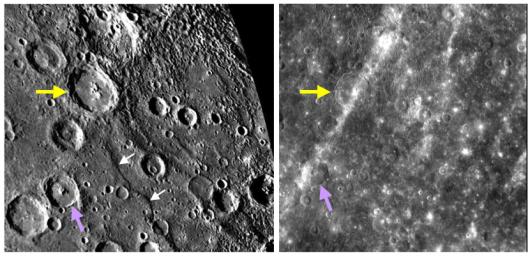
|
Changing Stripes
- Click the image above for a larger view
- Full-Res JPEG (2560 x 1237) (561.4 kB)
- Full-Res TIFF (2560 x 1237) (9.5 MB)
Caption:
This pair of images illustrates the dramatic effect that illumination and viewing geometry (i.e., the angle at which Sunlight strikes the surface, and the angle from which the spacecraft views the surface) has on the appearance of terrain on Mercury. The image on the right is a frame captured by MESSENGER's NAC as the spacecraft was departing the planet after its second Mercury flyby. On the left is a portion of a mosaic made from Mariner 10 clear-filter images, obtained by that mission in 1974. The yellow arrows point to the 90-kilometer- (56-mile-) diameter crater Asvaghosa (named for the first century AD Indian philosopher and poet), and the purple arrows indicate a smaller crater to the southwest. A bright ray, prominently visible in the high-Sun MESSENGER frame, crosses both craters. The stripe of high-reflectance material may have originated at Kuiper crater (to the southwest PIA11355 ) or may come from a newly imaged crater to the northeast ( PIA11356 ) that has an extensive ray system. This ray and others seen in the NAC image were mostly invisible to Mariner 10, because low-Sun illumination emphasizes topography instead of differences in reflectance. As another example, the curving scarp (cliff) named Santa Maria Rupes (white arrows in the left image) is visible in the Mariner 10 image by the shadow it casts, but this rupes disappears in the MESSENGER image when the Sun is high overhead. Images collected under both high- and low-Sun conditions are needed for geologists to develop a complete understanding of the features on a planetary surface. For another example of the appearance of Mercury under contrasting lighting conditions, see the October 11 featured image ( PIA11361 ).
Date Acquired:
October 6, 2008
Image Mission Elapsed Time (MET):
131774145
Instrument:
Narrow Angle Camera (NAC) of the Mercury Dual Imaging System (MDIS)
Resolution:
550 meters/pixel (0.34 miles/pixel)
Scale:
Asvaghosa crater is 90 kilometers in diameter (56 miles)
Spacecraft Altitude:
21,000 kilometers (13,000 miles)
Background Info:
These images are from MESSENGER, a NASA Discovery mission to conduct the first orbital study of the innermost planet, Mercury. For information regarding the use of images, see the MESSENGER image use policy .
Cataloging Keywords:
| Name | Value | Additional Values |
|---|---|---|
| Target | Mercury | |
| System | ||
| Target Type | Planet | |
| Mission | MESSENGER | Mariner |
| Instrument Host | MESSENGER | Mariner 10 |
| Host Type | Orbiter | Flyby Spacecraft |
| Instrument | Mercury Dual Imaging System (MDIS) | |
| Detector | Narrow Angle Camera (NAC) | |
| Extra Keywords | Color, Crater, Shadow | |
| Acquisition Date | ||
| Release Date | 2008-10-14 | |
| Date in Caption | 2008-10-06 | |
| Image Credit | NASA/Johns Hopkins University Applied Physics Laboratory/Carnegie Institution of Washington | |
| Source | photojournal.jpl.nasa.gov/catalog/PIA11367 | |
| Identifier | PIA11367 | |
